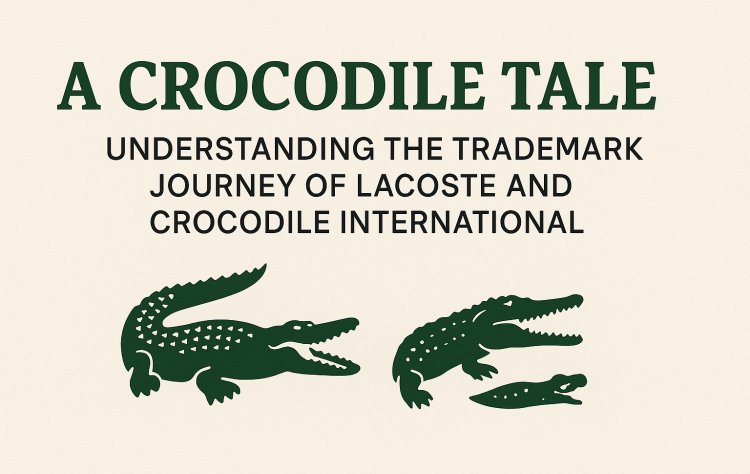A Crocodile Tale: Understanding the Trademark Journey of Lacoste and Crocodile International
Explore the fascinating trademark battle between Lacoste S.A. and Crocodile International Pte Ltd., a case that reached the Supreme Court of the Philippines. This landmark decision examined the Dominancy Test and clarified what constitutes confusing similarity under trademark law. Discover how both fashion giants defended their iconic crocodile logos, the court’s reasoning behind allowing coexistence, and the broader implications for brand identity, dilution, and global IP protection.

Introduction
Lacoste S.A., a beloved French fashion brand known for its iconic green crocodile logo, has been a staple in the fashion world since its founding in 1933 by René Lacoste and André Gillier. Initially focused on tennis apparel, Lacoste has expanded its offerings to include a wide variety of clothing, footwear, and accessories. What sets Lacoste apart is its unique blend of casual elegance and sporty style, which has created a strong brand identity and significant market influence. The company has enjoyed robust financial performance, largely due to its strong brand presence and diverse product range. With growth in revenue reported across major regions, especially in Europe and North America, Lacoste continues to thrive. Their commitment to innovation, sustainability, and strategic market expansion ensures a bright future, reinforcing their premium positioning in the global fashion landscape. Overall, Lacoste's lasting legacy is defined by its stylish apparel and the distinctive crocodile logo that people around the world recognize and love. On the other hand, Crocodile International Pte Ltd is a well-loved fashion apparel company that has been making waves since its establishment in 1947. Known for its sophisticated yet comfortable clothing line, the brand caters to a diverse range of demographics. With its headquarters in Singapore, Crocodile International mainly operates in Asia and has carved out a reputation for providing high-quality materials and timeless designs. Positioned as a leading player in the value fashion segment, the company offers stylish clothing at competitive prices, ensuring that a blend of style and durability is accessible to everyone. Many consumers in Asia appreciate Crocodile for striking the perfect balance between sophistication and affordability, making it a go-to choice for reliable and fashionable wardrobe essentials. Plus, the iconic Crocodile logo, with its sleek and simple crocodile graphic, adds a touch of charm to their fashionable offerings. Legal challenges have significantly impacted Crocodile International’s logo history, primarily involving Lacoste S.A. The similarity between their logos has led to a greater emphasis on trademark protections. Let’s discuss the case of Lacoste S.A. v. Crocodile International Pte Ltd., G.R. No. 223270 below.
The Supreme Court of the Philippines addressed a trademark dispute between two companies. Lacoste, a well-known French brand, has been registered as the owner of the "CROCODILE DEVICE" trademark in the Philippines since 1963 and has been marketing its products in the country for many years. On the other hand, Crocodile International Pte Ltd., a corporation based in Singapore, applied for its own "CROCODILE AND DEVICE" mark in 1996, intending to register it for goods in Class 25 of the Nice Classification. Crocodile argued that their trademarks were distinct enough to coexist as they had done in other jurisdictions.
Details of Lacoste’s registered mark covered by classes 1 to 42 are below.
|
Mark |
Registration No. |
|
|
64239 |
Details of Crocodile International’s mark covered by class 25 are below.
|
Mark |
Application No. |
|
|
4-1996-116672 |
However, Lacoste challenged the application, claiming that the logos were confusingly similar since both featured a crocodile. Crocodile responded, highlighting that their design included the word "Crocodile" in stylized text paired with a crocodile image that faced the opposite direction of Lacoste's logo, emphasizing the visual and aural differences between the two marks. This case illustrates the complexities of trademark rights and the importance of distinguishing brand identities in a competitive market.
The IPO-Bureau of Legal Affairs (IPO-BLA) made a decission against Lacoste, concluding that there was no confusing similarity between the marks and subsequently denied the opposition. This decision was supported by the IPO Director General and later upheld by the Court of Appeals, which applied both the Dominancy and Holistic Tests in its analysis. Unsatisfied with the outcome, Lacoste sought further review from the Supreme Court under Rule 45. The key issues at hand were whether there was indeed a confusing similarity between Lacoste’s and Crocodile’s marks that would prevent the registration of Crocodile’s mark in the Philippines and whether the doctrine of trademark dilution was applicable. Ultimately, the Supreme Court denied Lacoste’s petition and affirmed the rulings of the lower courts, firmly stating that no confusing similarity existed between the marks in question.
The court focused on the principles of trademark law, specifically applying the Dominancy Test to assess the likelihood of confusion between the marks of Lacoste and Crocodile. Lacoste's trademark features a distinctive right-facing crocodile, while Crocodile's mark is comprised of a left-facing crocodile alongside the word "Crocodile" in a stylish font. These visual differences, including their orientation and overall design, contribute to a unique commercial impression that sets them apart. Additionally, the court noted that both brands have managed to coexist peacefully in other countries, supported by various arbitral and judicial decisions abroad, and reinforcing the finding that there is no confusing similarity between the marks. Lacoste's claims of trademark dilution were not substantiated, as they couldn't demonstrate bad faith or actual harm to their brand. The court found Lacoste's consumer survey evidence to be unreliable due to certain methodological flaws, which diminished its impact. In conclusion, the court denied Lacoste's petition, affirming the earlier decisions and allowing Crocodile’s trademark application to proceed.
Conclusion
The significance of the Dominancy Test in resolving trademark confusion cases in the Philippines cannot be overstated. It serves as the principal standard, emphasizing that simply having similarities in design or concept doesn't automatically lead to a finding of confusing similarity. Instead, it's essential to consider the overall presentation and the dominant features of the marks involved. Additionally, there are objective standards that help determine how consumer surveys can be used in trademark cases, adding a layer of clarity to their admissibility and probative value. Lastly, while coexistence agreements and determinations from other jurisdictions can provide guidance, they do not dictate how Philippine law operates in these matters. This nuanced approach helps ensure fair and balanced outcomes in trademark disputes.












